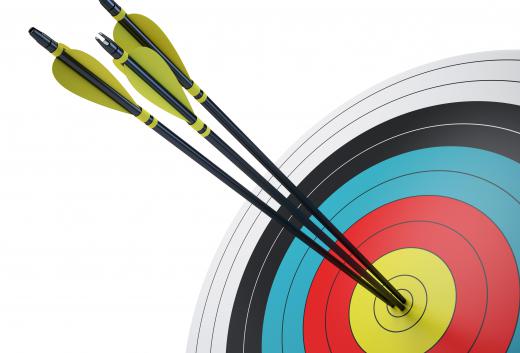A bow and arrow is one of the oldest man-made distance weapons. The bow and arrow, along with simple weapons like the sling, are unique from many other early weapons in that they use mechanical leverage to generate a great deal more force than a human could on their own. This allowed for the hunting of larger game, and allowed for hunting game at a distance. With the advent of gunpowder and modern firearms, the bow and arrow became less and less useful as a weapon or hunting tool, but are still used recreationally and in athletic competitions.
A bow is a fairly basic device made up of some sort of elastic structure that can bend, with two points and a string running between them. Traditionally the bow was made out of a flexible wood, while modern bows are made out of different materials such as carbon fiber or metals. Some traditional bows would use composites of different materials, including things such as horn, allowing for bows that could draw more.

The force of a bow and arrow is basically determined by how much tension the bow can take, known as its draw weight. The draw of a bow is limited by the lengths of the ends, the material the bow is made out of, the strength of the material used for the string, and how far back the archer can pull based on their arm length. A number of historical bow designs used tricks to allow a greater draw weight, including having the curve of the tips pull back in on themselves, in a design known as a recurve bow. Modern bows often make use of mechanical systems, looping the string, in most cases steel, through them to allow for much greater draws than would normally be possible.

The arrow used in a bow and arrow can take many different forms, but at its most basic consists of a long shaft with some sort of pointed object at the tip, and some sort of balancing device at the rear. The oldest bows had simple chipped stones, such as flint or obsidian, made into crude points as arrowheads, and basic feathers, known as fletching, used to balance the bow. Some arrow designs omit fletching entirely, but this is fairly rare, as fletching allows arrows to travel greater distances more directly, allowing for much greater accuracy for the hunter or warrior.

The earliest arrowheads, which we take as evidence for early man’s use of the bow and arrow, can be found in Africa more than twenty millennia ago. Eighteen millennia ago we have records of fletching used on the arrows, and sinews being used to tightly hold the arrowheads to the arrow body. This makes the bow and arrow, along with the sling and the atlatl, one of the early three ranged weapons.
Many people continue to use the bow and arrow for sport. A number of societies exist that practice shooting traditional style bow and arrow at targets, while modern bow and arrow is used in mainstream sporting events such as the Olympics, and for recreational and subsistence hunting. Most hunting supply stores have a good selection of modern composite bows and arrows, and many areas also have traditional bowyers and fletchers producing older-style bows and arrows.
